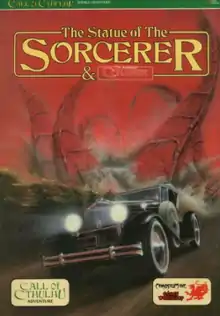The Statue of the Sorcerer & The Vanishing Conjurer
The Statue of the Sorcerer & The Vanishing Conjurer is a pack of two adventures published under license by Games Workshop in 1986 for Chaosium's horror role-playing game Call of Cthulhu.


Plot summary
The Statue of the Sorcerer & The Vanishing Conjurer contains two Call of Cthulhu adventures, presented back-to-back.[1]
- The Statue of the Sorceror is set in San Francisco in 1925, where the Investigators are approached by author Dashiell Hammett to investigate a con man defrauding older women of their life savings.[1]
- The Vanishing Conjurer is set in London, England in the 1920s, where the Investigators are asked to find a young stage magician who has disappeared. The Investigators must first infiltrate a mysterious guild of magicians by performing an audition to prove they are stage magicians. In an index, several simple tricks are described, and there is the option for players to present one or more of these to the Keeper as part of the audition.[1]
Publication history
The Vanishing Conjurer, 24 pages in length, was written by Mike Lewis and Simon Price, with interior illustrations by Ian Cook.[2]
The Statue of the Sorceror, a 36-page adventure, was written by Chris Elliot and Richard Edwards, with interior art by Tony Ackland.
For both adventures, David Oliver and Ian Varley provided the cartography and Lee Gibbons created the cover art. The two adventures, bound in a back-to-back softcover format with 16 pages of player hand-outs between them, was published under license by Games Workshop in 1985 as a 76-page softcover book.[2]
Reception
In the October 1986 edition of White Dwarf (Issue #82), Richard Meadows thought the plot of The Vanishing Conjurer to be "tight and a little linear, but on the whole this is an ideal adventure to introduce players to the game." Meadows was more enthusiastic about The Statue of the Sorcerer, saying that its inclusion "really makes this package worthwhile." He thought that "Everything is handled with a subtlety I've not seen in a [Call of Cthulhu] adventure for some time, and in a way that rewards intelligent deduction and penalises the usual blundering idiocies of poorer players." He concluded, "I heartily enjoyed this adventure and, more importantly, so did my players, though they were challenged to the limit of their abilities in some sections."[1]
Other references
- Stardate Vol.3 Issue 2 (March 1987, p. 104)
- The Annotated Unspeakable Oath Issue 3 (1993, p. 28)
- Abyss Issue 40 (Spring 1987, p. 21)
References
- Meadows, Richard (October 1986). "Open Box". White Dwarf. No. Issue 82. pp. 2–3.
- Schick, Lawrence (1991). Heroic Worlds: A History and Guide to Role-Playing Games. Prometheus Books. p. 245. ISBN 0-87975-653-5.